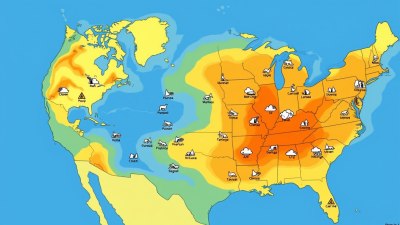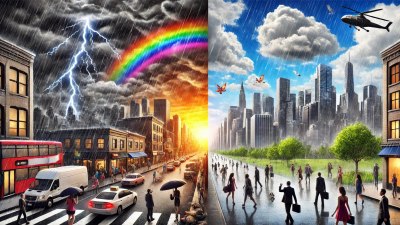Why Stormy Weather = Sudden Online Retail Therapy Session
Discover the psychological link between stormy weather and the rise in online retail therapy sessions.

Stormy weather often stirs a range of emotions within us, and it has been observed that many individuals turn to online retail therapy as a coping mechanism during such times. This phenomenon is not only intriguing but also reflects a deeper psychological relationship between our environment and our behaviors. In this article, we will explore the influences of stormy weather on consumer behavior, the psychological rationale behind retail therapy, and how businesses can harness this knowledge to enhance customer engagement.
The Psychological Link Between Weather and Mood
The first step to understanding the relationship between stormy weather and online shopping behavior is to consider how weather affects our mood. Research shows that weather conditions, particularly stormy or gloomy days, can lead to an increase in feelings of sadness, anxiety, and even depression. During these times, individuals often seek solace and comfort, which can lead to the act of shopping as a form of escape.
Retail Therapy: A Brief Overview
Retail therapy refers to the act of shopping to improve one's mood and emotional well-being. The concept is simple: when we buy something new, our brains release dopamine, often referred to as the 'feel-good hormone'. This chemical reaction can create a sense of temporary happiness and fulfillment, making shopping an appealing option during a gloomy storm. With the rise of e-commerce, accessing this therapy has become easier than ever, resulting in a surge in online shopping, particularly during bad weather.
Why Stormy Days Trigger Online Shopping
1. **Indoor Activity**: Stormy weather conditions often restrict outdoor activities. When staying indoors, a common leisure activity becomes browsing the internet. With accessible devices like smartphones and laptops, scrolling through online stores is both tempting and convenient.
2. **Emotional Comfort**: Individuals experiencing negative emotions often seek ways to alleviate their discomfort. The act of purchasing something can offer immediate relief and a sense of control over their otherwise tumultuous environment. Whether it's a cozy blanket, a new pair of shoes, or a quirky piece of home decor, buying items that bring comfort or joy can be appealing during stormy weather.
3. **Escape from Routine**: Stormy weather tends to confine people to their homes, leading to feelings of restlessness or boredom. Entering the world of online shopping provides a temporary escape from mundane routines. Browsing through vibrant products can stimulate excitement and distract from the dreariness outside.
The Impact of E-Commerce on Retail Therapy
The digital landscape has revolutionized the way consumers shop. Online retailers often capitalize on this emotional aspect, creating targeted marketing strategies that appeal to customers' feelings. Stormy weather could trigger a specific type of campaign aimed at those likely to engage in retail therapy. These could include:
1. **Email Promotions**: Retailers can send personalized emails with discounts or suggestions that evoke comfort and coziness, such as offers on home goods, warm clothing, or even gourmet comfort food.
2. **Social Media Targeting**: Advertisements on social media platforms can tap into the sentiments associated with stormy weather. Scenarios that highlight relaxation or comfort could be presented, enticing consumers to shop while they cozy up indoors.
3. **Influencer Marketing**: Collaborating with influencers who resonate with the emotional tone of stormy weather can enhance the reach and effectiveness of promotional campaigns. These influencers can promote products that evoke feelings of comfort and cheer.
The Evolution of Consumer Behavior
Consumer behavior is constantly changing, especially in response to societal shifts and technological advancements. The pandemic has accelerated the growth of e-commerce and revealed how online shopping caters to emotional needs. People harness shopping to cope with loneliness, boredom, and even anxiety associated with uncertain times. As a result, understanding the triggers for online shopping is crucial for businesses aiming to engage and retain customers.
Case Studies of Stormy Weather Shopping Trends
Several studies have been conducted to analyze consumer behavior fluctuations during poor weather conditions. One notable study indicated an increase of up to 30% in online purchases during inclement weather compared to sunny days. Categories such as home and garden, clothing, and health products saw the most significant spikes.
Other platforms have echoed these findings, noting that during stormy weekends, consumers are more likely to purchase items that make their home environment feel cozier. For instance, sales on home appliances, slow cookers, and even board games would surge, showcasing how people attempt to make the best out of dreary conditions.
The Future of Retail Therapy and Weather Influences
As climate change and extreme weather events become more prevalent, understanding how these factors influence consumer behavior is essential. Retailers must continually adapt their strategies to fit the evolving landscape. Big data and analytics can play a vital role in predicting shopping patterns based on weather forecasts. Companies that anticipate changing consumer needs can position themselves advantageously.
In conclusion, stormy weather undeniably plays a significant role in triggering online retail therapy sessions. The psychological factors behind this behavior are rooted in our desire for comfort and escape, which shopping can provide during gloomy times. As retailers capitalize on this phenomenon through targeted marketing and product offerings, consumers benefit from the uplifting experience of finding joy in their purchases, even amidst a storm outside. The intersection of mental health, weather, and e-commerce continues to evolve, presenting ongoing opportunities for studying and understanding consumer behavior.











